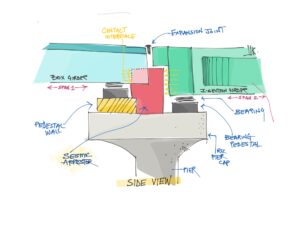
Seismic arrestors, also known as seismic energy dissipators or seismic dampers, are structural devices or systems designed to absorb and dissipate seismic energy during an earthquake. They are commonly used in the piers of bridges to enhance their seismic performance and mitigate the effects of seismic forces.
The primary purpose of seismic arrestors in bridge piers is for reducing the forces and displacements experienced by the bridge during an earthquake. These devices help to protect the bridge-structure and its components from excessive damage, ensuring the safety and functionality of bridge.
There are various categories of seismic arrestors used in bridge piers, including:
- Fluid-Viscous Dampers: It uses the flow of fluid through a restricted orifice to dissipate seismic energy. They consist of a piston or plunger moving through a viscous fluid, generating damping forces that absorb and dissipate the seismic energy.
- Friction-Pendulum System: This system utilizes a pendulum-like device with a sliding interface that provides controlled frictional resistance during an earthquake. The sliding interface allows for relative movement between the superstructure and substructure, reducing the transmitted forces.
- Steel Yielding Devices: Steel dampers or steel-plates, are designed to yield and deform under seismic forces. By dissipating energy through plastic deformation, they effectively reduce the forces transmitted to the bridge structure.
- Tuned Mass Dampers: Tuned mass dampers are used to control the dynamic response of a structure. They consist of a mass attached to the bridge pier through springs or dampers. The mass is tuned to a specific frequency, effectively reducing the dynamic response and minimizing the bridge’s vibrations during an earthquake.
The specific type of seismic arrestor used in bridge piers depends on factors like bridge’s design, expected seismic forces, and desired performance objectives. These devices are typically incorporated into the bridge’s design and are installed during construction or retrofitted to existing bridges to enhance their seismic resilience.

